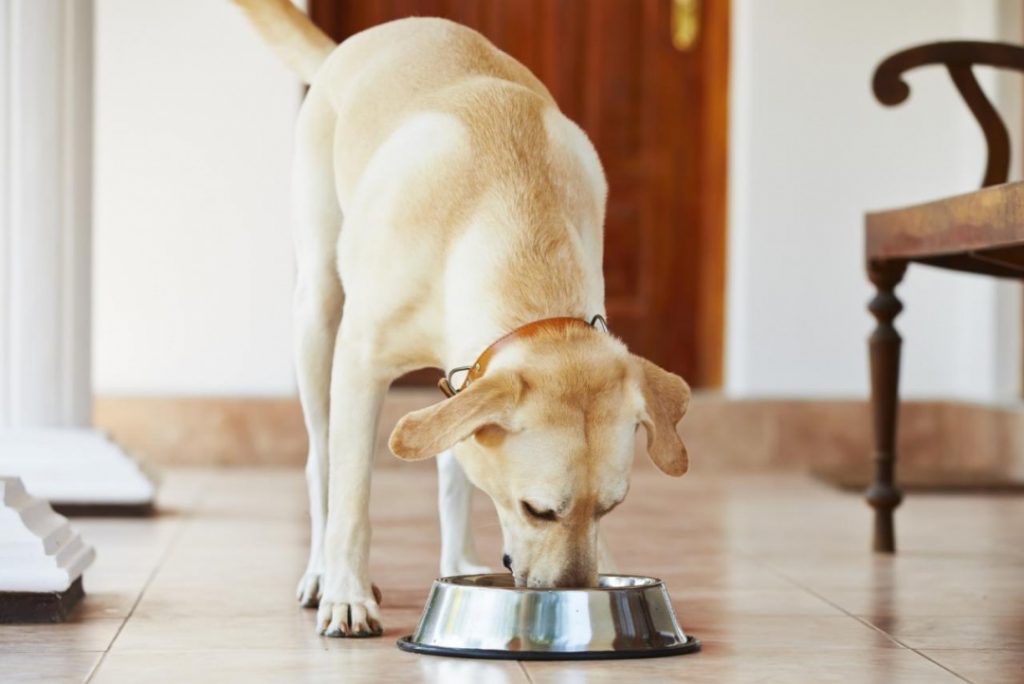Walking down the food aisle in a pet store can be overwhelming. There are literally dozens of different dog foods available to you, each spouting specific health benefits. Which food should you choose?
There are a few things to consider when looking at which dog food is best for your canine pal.
1. Understand the terminology
There are specific guidelines to what pet food must contain, according to the wording on the package. Understanding what these words mean will help you decide on the best food option.
If the package says it is made with one ingredient, such as chicken, then that ingredient must make up 95% of the actual food. Likewise, if a combination of foods is prominent, such as chicken and beef, that combination must make up 95% of the food.
If you see words such as dinner, entrée or platter, the main ingredient on the front of the package must form at least 25% of the food. Where the label says “with” an ingredient, there only has to be 3% of that specific ingredient.
For example, if the label says Dog Food with Liver, the mixture probably contains just 3% liver. Flavors mean there is probably very little of the actual food in the container.
2. Check the ingredients list
You will see the ingredients are listed in order of weight. This does not necessarily mean that the first ingredient is the most abundant.
Chicken, for example, may weigh more than corn because it has moisture in it, but there could be more corn flour than chicken.
More: 10 Most Popular Dog Names
3. Look for grains
Most pet foods include grains as a source of carbohydrates. Some will even use gluten to help create a more filling product. While these ingredients are not exactly a bad thing, you may prefer to pay a little more for something that contains more protein.
If your dog is allergic to grains, you definitely want to skip dog foods made with wheat.
More: 10 Most Popular Myths about Dogs
4. Choose a food your dog likes
It doesn’t matter how much research you’ve done, if your dog simply doesn’t like the food, don’t buy it.
You will need to balance all of the above factors with what your pet prefers. It’s a good idea to have food your dog likes or you’ll find yourself tossing a very expensive bag of food.
More: 10 Best Dog Breeds for Children
5. Decide on dry or wet
The big question for most dog owners is whether to feed their dog wet or dry food. There are pros and cons to each.
Wet dog food comes in pouches or cans. It is great for picky eaters and your dog will probably like it best.
However, you will need to feed more wet food than dry in order to get the same nutritional benefits. The wet food is made up of a lot of water. It is also more expensive.
Dry food offers more nutrition at a lower price and is better for keeping teeth clean. However, if your dog is picky, he will be less likely to eat dry food.
More: 10 Reasons Why Cats Are Better Than Dogs
6. Does your pet need special food?
Specific dog foods are often tailored for stages or sizes. For example, puppy food will be different than food designed for an adult or elder dog. Puppies are usually fed a special formula for the first year of life. Food for the growing pup should include higher amounts of fat, phosphorous and protein to keep the puppy healthy.
Adult mixes will reduce these levels. Older dogs may benefit from a lower calorie food to prevent obesity, but this is not always necessary. Talk to your vet to find out if you should be using specific formulas.
Other specialty foods include foods for small breeds, large breeds, overweight dogs, highly active or sedentary pets, and dogs suffering from allergies or skin conditions. These should only be chosen if your vet recommends them.
More: 9 Unique Dog Breeds You May Never Come Across
7. Check with your vet
As recommended above, you can ask your vet which food is best for your dog. Some veterinarians will give you a specific brand of food to buy, while others will simply tell you what to look for.
More: 8 ‘People’ Foods Your Dog Can Eat Too
8. Watch for animal byproducts
While not all animal byproducts are bad, they do tend to be lower quality ingredients, so you may want to reconsider using a food that lists these high in the ingredient’s list.
Animal byproducts are usually pieces of animals that are not fit for human consumption.
More: 7 Interesting Things You May Not Know about Dogs
9. Check portion sizes
Most dog food packages will let you know how much to feed your pet, depending on the size. Reading this part of the package will give you a better idea of just how long a package will last.
If you are on a tight budget, you may need to choose a dog food that offers more fiber and filler to keep your dog full. The high protein foods usually cost more because the ingredients are more expensive.
More: 10 Most Unique Pets You Can Own
10. Check the additives
Some animals are sensitive to food colorings and other additives. Many pet foods include preservatives or other chemicals to add flavor. Check for these if your dog is sensitive.
A big part of taking care of your dog is ensuring that he is receiving the right nutrition. Choosing the best food possible is a big responsibility, but your pet will appreciate it.



















Comments